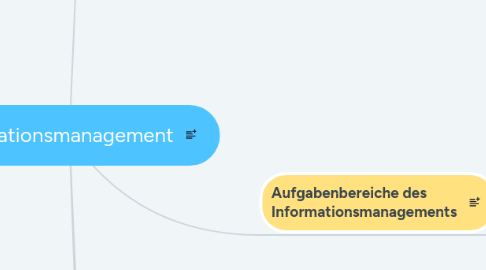
1. Bedeutung von Information & Kommunikation
1.1. Annäherungen an den Informationsbegriff
1.1.1. Zeichen
1.1.2. Daten
1.1.3. Information
1.1.4. Wissen
1.2. Information als Wirtschaftsgüter, wenn:
1.2.1. Für einen Zweck geeignet, entsprechend Zielsetzung
1.2.2. Im eigenen Wirkungsbereich vorhanden und verfügbar
1.2.3. zwischen Wirkungsbereichen übertragbar
1.2.4. relativ knapp, aber nachgefragt
1.3. Information als Produktionsfaktor
1.4. Information als immaterielles Wirtschaftsgut - Eigenschaften:
1.4.1. Werden durch Nutzung nicht verbraucht
1.4.2. Lassen dich in digitaler Form ohne Wertverlust fast beliebig teilen
1.4.3. Sharing verursacht keine/geringe Kosten
1.4.4. Wert ist schwer bestimmbar und von Zeit/Kontext abhängig
1.4.5. Security ist problematisch
1.4.6. Gleichzeitig im Besitz von mehreren Personen
1.4.7. Erweitern, Weglassen, Auswählen, Verdichten verändert Qualität
1.5. Kommunikation
1.5.1. Human to Human
1.5.2. Human to Machine
1.5.3. Machine to Machine
2. Aufgabenbereiche des Informationsmanagements
2.1. Modelle:
2.1.1. Aufgaben- & problemorientiert
2.1.2. Prozessorientiert
2.1.3. Architekturorientiert
2.1.4. Ebenenorientiert
2.2. Aufgaben:
2.2.1. Informationsversorgung
2.2.1.1. Ziel: Informationsstand verbessern
2.2.1.1.1. Informationsangebot
2.2.1.1.2. Informationsnachfrage
2.2.1.1.3. Informationsbedarf
2.2.1.2. Informationsversorgungsprozess
2.2.1.2.1. Informationsbedarfsermittlung
2.2.1.2.2. Informationsbeschaffung
2.2.1.2.3. Informationsübermittlung
2.2.1.2.4. Informationsverwendung
2.2.2. Informationssystem & -technik
3. Organisation des Informationsmanagements
3.1. Chief Information Officer
3.2. IT-Controlling
3.3. IT-Kennzahlen
3.3.1. Management
3.3.2. Technische Infrastruktur
3.3.3. Software/Systemstruktur
3.3.4. IT-Personal
3.4. IT-Abteilung
3.5. Outsourcing
3.6. Shared Service Center
4. Strategische Bedeutung des Informationsmanagements
4.1. Informationssystem-Typen
4.1.1. Unterstützung (O low, S low)
4.1.2. Fabbrik (O high, S low)
4.1.3. Durchbruch (O low, S high)
4.1.4. Waffe (O high, S high)
4.2. Unterstützungs- vs. Enablementfunktion
4.3. Strategische Funktionen
4.3.1. Strategieausführung
4.3.2. Strategie Übersetzung
4.3.3. Optimierung & Reorganisation
4.3.4. Wettbewerbspotenziale
